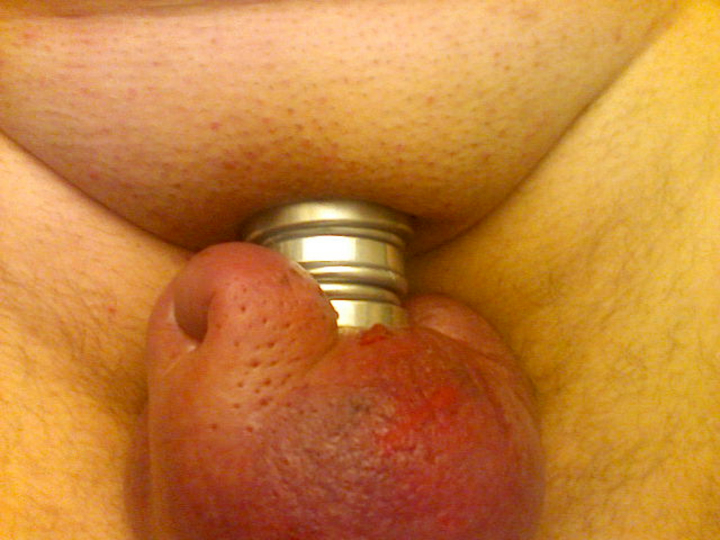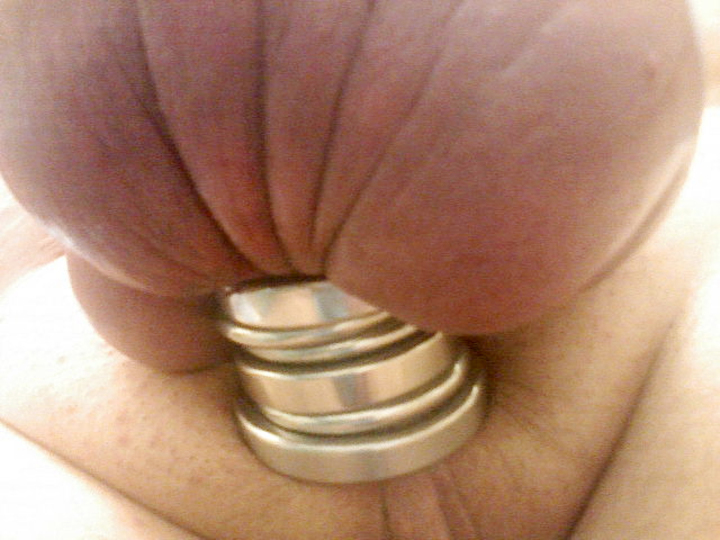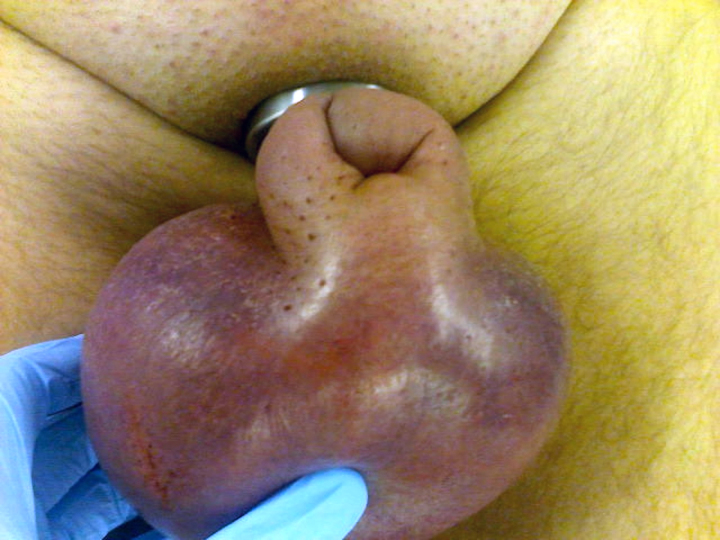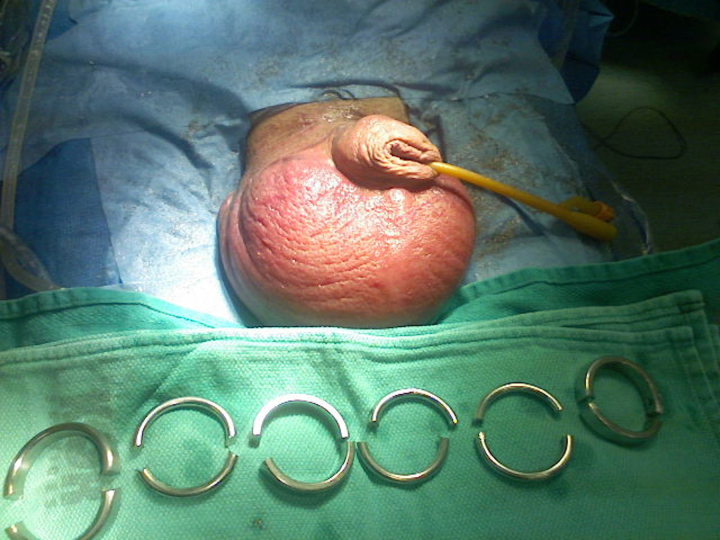Abstract
Incarceration or strangulation of the penis is a rare clinical situation that requires emergent urologic management to prevent potentially devastating outcomes. Many different techniques have been described in the literature to remove genital foreign objects, but there is no universally successful technique. We present an unusual and challenging case involving incarceration of both the penis and scrotum by multiple metallic rings that required operative removal using an orthopedic high-speed drill.
Introduction
Penile incarceration or strangulation is a rare urologic emergency with only 60 cases reported in the literature to date. It is however, not a new phenomenon; the first reported case dates back to the 18th century.1
The use of genital foreign objects is most commonly done intentionally in an attempt to increase sexual performance and to heighten sexual sensation and orgasm.2 A wide variety of objects have been reported, including plastic and steel rings,3–5 ball-bearings,6,7 nuts,8,9 washers,10 wedding rings,2,11 bottles,12 rubber bands13 and even a hammer head.5
The placement of these objects over the more malleable flaccid or partially erect penis often results in the inability to remove them afterwards secondary to the edema that ensues, especially if the period of genital constriction is prolonged. The presence of these constricting devices results in a potential penile compartment syndrome with an initial obstruction of both venous and lymphatic outflow distal to the device followed by arterial inflow obstruction, ultimately resulting in tissue ischemia and necrosis.13,14
Genital incarceration or strangulation represents a true urologic emergency that requires prompt decompression of the involved tissues. Numerous techniques have been described in the literature; however there exists no universal technique given the varied nature of the constricting devices and individual presentations.
Case report
An otherwise healthy 53-year-old male presented to the emergency room of the Royal Alexandra Hospital in Edmonton, Alberta, with complaints of worsening penile and scrotal pain and swelling. On history, he had placed 7 metallic rings around his penis and his scrotum 72 hours earlier for auto-erotic purposes. He had tried multiple times to remove these rings himself, but was successful only in removing 1 ring using a hand-held household rotary motor tool with circular cutting attachment 6 hours prior to his presentation.
Physical examination demonstrated a grossly edematous penis and scrotum which were incarcerated by 6 stainless steel rings of various dimensions, but in total measuring 8 cm in length. His scrotal skin was intact, but it was cool and dusky and demonstrated diminished sensation (Fig. 1) (Fig. 2). With both his scrotum and penis incarcerated through these rings, it was impossible to manually remove them; it also proved impossible to cut them off using standard bolt-cutters as there was no room between the individual rings given the amount of tissue edema present. Given the appearance of impeding skin necrosis and the unsuccessful removal of these rings in the emergency room, he was taken immediately to the operating room (Fig. 3). Orthopedic surgery consultation intra-operatively suggested the use of the Midas-Rex pneumatic drill with metal cutting carbide attachment (Medtronic Inc., Fort Worth, TX). This tool was used successfully to safely remove all 6 steel rings without tissue trauma in a total operative time of 45 minutes (Fig. 4). A slim, orthopedic periosteal elevator was used to protect the underlying skin during the cutting and the metal was cooled with the continuous flow of sterile water through a continuous bladder irrigation set-up. After the removal of the rings, the underlying skin was intact and showed no evidence of breakdown or necrosis. The patient was discharged on postoperative day 2 in excellent condition.
Fig. 1.
Perineal view demonstrating incarceration of scrotal contents.
Fig. 2.
Anterior view demonstrating extensive penile and scrotal edema.
Fig. 3.
Intra-operative picture after ring removal demonstrating resolution of edema and absence of skin breakdown.
Fig. 4.
Anterior view demonstrating impending skin necrosis of the penis and scrotum.
Discussion
Incarceration or strangulation of the penis by constricting devices, such as metal rings, is rare with only 60 reported cases in the literature. Incarceration of both the penis and the scrotum is even more rare with only 2 other cases described.2,15 Both situations represent urologic emergencies as the consequences of vascular occlusion of the genitalia, such as penile skin loss, erectile dysfunction, urethral-cutaneous fistula, and even penile loss, can be devastating.16 Numerous methods of object removal have been described in the literature, but none are universally applicable given the wide variation in patient presentation and type of constricting device. Prompt recognition and urgent decompression of the involved tissues are required to avoid these complications. Santucci and colleagues have described the emergency room use of a fire department air driven circular grinder to remove 2 metal penile foreign bodies.17 However, we feel that the use of a widely available precision surgical tool in the operating room is the safest approach to remove genital constricting devices refractory to other methods.
Footnotes
Competing interests: None declared.
This paper has been peer-reviewed.
References
- 1.Gautier M. Observation d’un entanglement et des testicules et de la verge, occasione par le passage d’un briquette. J Med Chir Pharmacol. 1755;3:358. [Google Scholar]
- 2.Perabo FG, Steiner G, Albers P, et al. Treatment of penile strangulation caused by constricting devices. Urology. 2002;59:137. doi: 10.1016/s0090-4295(01)01485-6. [DOI] [PubMed] [Google Scholar]
- 3.Patel C, Kim R, Delterzo M, et al. Prolonged penile strangulation with metal clamps. Asian J Androl. 2006;8:105–6. doi: 10.1111/j.1745-7262.2006.00078.x. [DOI] [PubMed] [Google Scholar]
- 4.Browning WH, Reed DC. A method of treatment for incarceration of the penis. J Urol. 1969;101:189–90. doi: 10.1016/s0022-5347(17)62307-3. [DOI] [PubMed] [Google Scholar]
- 5.Chakrabarty PB, Das BK. Strangulation of penis by metal ring. J Indian Med Assoc. 1976;67:256. [PubMed] [Google Scholar]
- 6.Bucy JG. Removal of strangulating objects from the penis. J Urol. 1968;99:194–5. doi: 10.1016/S0022-5347(17)62671-5. [DOI] [PubMed] [Google Scholar]
- 7.Vähäsarja VJ, Hellström PA, Serlo W, et al. Treatment of penile incarceration by the string method. J Urol. 1993;149:372–3. doi: 10.1016/s0022-5347(17)36088-3. [DOI] [PubMed] [Google Scholar]
- 8.Tiwari VS, Razdan JL, Yadav VN. Strangulation of the penis by a metallic nut. Int Surg. 1977;62:558–60. [PubMed] [Google Scholar]
- 9.Schellhammer P, Donnelly J. A mode of treatment for incarceration of the penis. J Trauma. 1973;13:171–3. doi: 10.1097/00005373-197302000-00013. [DOI] [PubMed] [Google Scholar]
- 10.McCally DS, Goldfarb M, Finelli R, et al. Removal of a strangulating object from the penis. Urology. 1979;14:209. doi: 10.1016/0090-4295(79)90166-3. [DOI] [PubMed] [Google Scholar]
- 11.Stephens JRW. Penis captivus. Br Med J. 1921;1:662. [Google Scholar]
- 12.Pannek J, Martin W. Penile entrapment in a plastic bottle. J Urol. 2003;170:2385. doi: 10.1097/01.ju.0000095242.41852.83. [DOI] [PubMed] [Google Scholar]
- 13.Markland C, Merrill D. Accidental penile gangrene. J Urol. 1972;108:494–5. doi: 10.1016/s0022-5347(17)60784-5. [DOI] [PubMed] [Google Scholar]
- 14.Snoy FJ, Wagner SA, Woodside JR, et al. Management of penile incarceration. Urology. 1984;24:18–20. doi: 10.1016/0090-4295(84)90379-0. [DOI] [PubMed] [Google Scholar]
- 15.Dekou A, Konan PG, Ouegnin GA, et al. Treatment of incarceration of the penis and scrotum [in French] Prog Urol. 2006;16:623–4. [PubMed] [Google Scholar]
- 16.Carney JDD, McAninch JW. Retained penile constriction devices: management and complications. J Urol. 2001;165:83. [Google Scholar]
- 17.Santucci RA, Deng D, Carney J. Removal of metal penile foreign body with a widely available emergency-medical-services-provided air driven grinder. J Urol. 2004;63:1183–4. doi: 10.1016/j.urology.2004.01.021. [DOI] [PubMed] [Google Scholar]






